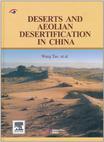中国沙漠与沙漠化
出版社:科学出版社
出版日期:2011-6
ISBN:9787030173386
作者:Wang Tao 编
页数:819页
作者简介
《中国沙漠与沙漠化(英文版)》内容简介:Atmospheric protection, biodiversity conservation and combating desertification are environ-mental issues relating to human existence that need to be solved urgently in the new century.Aeolian desertification is one of the most signifcant desertification types. China is one of thecountries suffering from the most serious aeolian desertification in the world. Deserts and aeoliandesertified land in China covers an area of 1.669 million km2, of which aeolian desertified landcaused by human activity covers 385,700 km2. Although the Government of China has been givingtop priority to the control of aeolian desertification, it is still in a situation of Local Rehabilitationand Overall Deterioration, and aeolian desertification is developing continuously and rapidly. Landaeolian desertification in China developed at a rate of 1,560 km2/a during the 1960s-1970s, 2,100km/a in the 1980s and 2,460 km2/a during 1990——2000.
书籍目录
Summary
Preface One
Preface Two
Foreword
Part Ⅰ Overview of Deserts and Aeolian Desertification in
China
Chapter 1 Introduction
1.1 Progress in desert research in China
1.1.1 An overview of desert research history in China
1.1.2 Progress in desert research of China
1.2 Aeolian desertification research and its progress in
China
1.2.1 Initial research into aeolian desertification in
China
1.2.2 Progress in aeolian desertification research over the past
ten years
1.3 Development trend in the researches of deserts and aeolian
desertification in China
1.3.1 Development trend of desert research
1.3.2 Development trend of aeolian desertification research
References
Chapter 2 Outline on Natural and Socio-economical Features of
Deserts and Aeolian Desertified Regions
2.1 Climate
2.1.1 Arid climate evolution in sandy regions
2.1.2 Basic characteristics of the climate in sandy areas in
China
2.1.3 Climate zonation of sandy areas in China
2.2 Geomorphology
2.2.1 Regionally controlled geomorphology units
2.2.2 Aeolian geomorphology in sandy areas
2.3 Hydrology
2.3.1 Runoff features in desert regions
2.3.2 Hydrology of rivers and lakes in desert regions
2.3.3 Flood and drought hazards
2.3.4 Groundwater basins
2.3.5 Hydrological regionalization in desert regions
2.4 Soil
2.4.1 Sandy Entisols
2.4.2 Other Sandy Entisols
2.5 Vegetation
2.5.1 Flora
2.5.2 Vegetation types and their distribution
2.6 Social and economic situations
References
Chapter 3 Classification and Distribution of Deserts and Aeolian
Desertified Lands in China
3.1 Classification and distribution of deserts in China
3.1.1 A history of the concept of deserts in China
3.1.2 Classifications of deserts
3.1.3 Distributions of deserts in China
3.2 General characteristics of Chinese deserts
3.2.1 Arid climate and low precipitation
3.2.2 Abundant heat resources and high temperature
difference
3.2.3 Frequent blown sand activities
3.2.4 Sparse and low vegetation, and few kinds of animals
3.2.5 Huge sandy sediments
3.2.6 Shifting dunes moving along the dominant wind
direction
3.2.7 Little runoff, abundant underground water
3.2.8 Soil formation in the initial stage
3.3 Types and characteristics of aeolian desertification in
China
3.3.1 Aeolian desertification and aeolian desertified land
3.3.2 Types of aeolian desertification and aeolian desertified
land
3.4 Rules and characteristics of aeolian desertified land
distribution in China
3.4.1 Spatial distributions
3.4.2 Temporal trends of aeolian desertification
References
Chapter 4 Natural Resources in Desert Regions
4.1 Climatic resources
4.1.1 Concept and characteristics
4.1.2 Evaluation of climatic resources in desert regions
4.1.3 Climatic disaster and the exploitation and usage of
climatic resource
4.2 Water resources
4.2.1 Water resources in inland desert regions of northwest
China
……
Part Ⅱ Evolution of Deserts and Aeolian Desertification in
China
Part Ⅲ Case Study of Deserts and Aeolian Desertification in
China
Part Ⅳ Control of Deserts and Aeolian Desertification
章节摘录
Statistical data shows that, the surface area of year round barren land surface in the sandy areas inChina is quite large, with a total area of basically no-vegetated or totally barren land occupying 1,115.9thousands km2, accounting for 87.0% of the statistical area. At the same time there are many moresteppes and farmlands having a period of roughly half a year of barren surfaces after the seasonalharvesting or natural withering, and this period can vary from six to nine months with very little snowcover. Obviously, these two land surfaces often have seasonal or yearly radiation feedback. Studies on radiation balances for sandy areas in China clarified that radiation energy losses aredramatically huge in western sandy areas. Among them, there is an extreme radiation energy lossalong the border of Gansu-Xinjiang, including eastern and southern Xinjiang. The loss is big enoughto be compared with that of the Sahara Desert's center, also attaining up to 70%. In addition, allenergy losses of the deserts are bigger than those of the nearby mountainous areas. The loss rate ofthe deserts is 66% to 68%, but the rate of the mountain areas reaches only 63% or much lower. Thedifferences in feedback, as well as the larger feedback of China's desert areas can be explained bytaking into account that sandy areas in China are located in the temperate-zone, as well as the strongreflectivity of the snow-ice surfaces on the high mountains and plateaus. ……
图书封面
